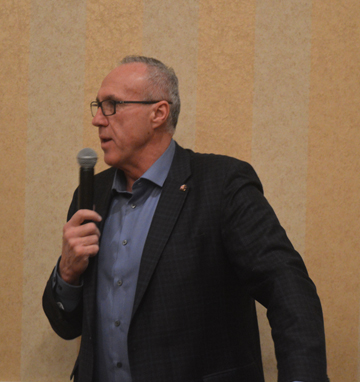Current Temperature
2.7°C
Medicine Hat-Cardston-Warner’s child poverty rate sits above national average
Posted on June 21, 2018 by Westwind Weekly Westwind Weekly file photo by Jeremy Appel
Medicine Hat-Cardston-Warner MP Glen Motz
Westwind Weekly file photo by Jeremy Appel
Medicine Hat-Cardston-Warner MP Glen MotzPeggy Revell
Southern Alberta Newspapers
Two out of 10 children in the Medicine Hat-Cardston-Warner federal riding live in poverty, according to statistics compiled by the anti-poverty advocacy group Campaign 2000.
“There are nearly 3,000 families with children that are considered low income in the Medicine Hat (riding) area,” said Joel French, executive director of Public Interest Alberta, one of 120 organizations involved in the nationwide campaign to end child and family poverty.
Data on child poverty rates for federal ridings was released this week by Campaign 2000, to coincide with the nation’s first ever poverty reduction strategy, being released by the federal government in coming weeks.
According to Campaign 2000 data, 62 out of 337 ridings were at or above the national child poverty rate of 17.4 per cent. Medicine Hat’s riding rate is 20.4 per cent.
The riding of Churchill-Keewatinook Aski, Man., had the highest rate of 64.2 per cent, while the lowest rate was 6.3 per cent in the riding of Vaudreuil-Soulanges, Que.
“Medicine Hat isn’t among the worst, but still isn’t great,” said French, and the study shows problems in every riding across the country.
The analysis also found ridings with the highest level of child poverty had the highest proportion of Indigenous people, recent immigrants and mother-headed lone parent families.
Local MP Glen Motz says the child poverty rate for Medicine Hat’s riding is, unfortunately, not surprising.
“My involvement directly in Medicine Hat over the years showed that there are a lot of families and children in need,” he said.
There are many factors that go into the rates, said Motz — such increases to cost of living, gas, taxes, heating and food — which social assistance isn’t keeping up with.
Kainai First Nation also faces challenges, he said, but stressed the First Nation community isn’t the sole reason for this riding’s child poverty rates.
The federal government isn’t in the position to fix poverty all by itself, he said,
“It’s partnering with communities and action on the ground,” he said, noting that’s how Medicine Hat has “impacted homelessness,” and how the approximate year-old THRIVE initiative is focusing on poverty reduction and wellness.
On the federal end, Motz cited CPC actions while in power — the Universal Child Benefit, reducing the GST, raising the basic deduction threshold on taxes and rolling out the homeless housing first strategy. Motz also pointed to the private member bill put forward by a CPC colleague to reduce clawbacks so those on income support aren’t penalized if they find work.
Alberta is one of only two provinces that doesn’t have its own provincial poverty strategy, said French. “So this is a double problem in Alberta, that neither of those levels of government have a strategy right now.”
With a federal strategy coming, French said it’s important for the public to hold the government accountable.
“I think there’s a danger when these kinds of strategies come out that they can come out with really good reports, and really good language, but not actually have a significant impact on the poverty levels … We need to ensure that in the years following it actually results in an impact on poverty and seeing the levels come down.”
Leave a Reply
You must be logged in to post a comment.

